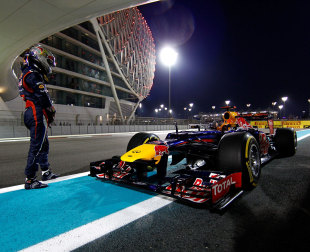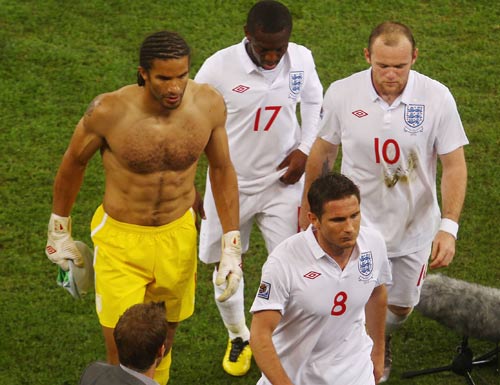
There have been tears, tantrums and tribulations along the way, but in Brazil Sebastian Vettel finally made it three out of three. Looking back at the record books in 20 years time, young F1 fans may be led to believe that Vettel had it all his own way in the early part of this decade, and while that was true in 2011, it couldn't be further from the truth this year.
For the first time since 2009 Vettel did not start the season with the best car and it took Red Bull 14 rounds to truly nail the performance of the RB8 around the time of Singapore. When it got it right, Vettel duly won four races on the trot, a feat unimaginable earlier in the season and the key to his title success. But it is the period before that that is most telling; the period when Vettel didn't have the best car.
The story starts before pre-season testing when technical directives further limited the team's use of exhaust gases and called for more strenuous tests of flexibility for the front wing. The directives came relatively late and had a significant effect on the burgeoning RB8 in Milton Keynes. The car that turned up to pre-season testing, therefore, was not exactly the car Adrian Newey had in mind when he first laid pen to paper and was, in essence, a compromise. Moreover, it was a big departure from the RB7, which had been based around the team's expertise in exhaust blowing, and had different driving characteristics.
To his credit Vettel adapted and took a solid second place at the opening round, but this was a car that would develop over the course of the season more than any other Vettel had ever driven. Not all the upgrades carried the fluid progression in performance that he had become accustomed to and in China Vettel shunned the team's latest exhaust development and opted for an unusually conservative approach of reverting back to the pre-season layout he had felt more comfortable with. It proved to be a mistake and he was beaten by team-mate Mark Webber fair and square. For the first time in three years Vettel looked a little lost.
But, as he has done so often in his short career, he learned his lesson and redoubled his efforts. At the next race in Bahrain he won, holding off a genuine threat from Kimi Raikkonen's Lotus. Panic over ... well, kind of.
The Red Bull still wasn't the fastest car race-in-race-out and, of more concern to the man himself, he wasn't always the fastest driver in the team. Webber ground out results in Monaco and Silverstone, while Vettel shone in Valencia only to be robbed of certain victory by an alternator failure. By the summer break he was third in the championship with a 42-point deficit to Fernando Alonso.
On F1's return Red Bull still didn't have the fastest car at Spa and at the Italian Grand Prix there was added concern as Vettel had his second alternator failure of the season. But Red Bull bounced back and by the time the teams left Europe things started to change. The team nailed its Coanda-effect exhaust and brought a new double DRS design to the rear wing. From that point onwards the car was improving with every update - and there were lots. Vettel, now with the car underneath him, won in Singapore when Lewis Hamilton retired and went on to win the next three races to take the lead in the championship. This was the Vettel we were used to.
Speaking about the car pre-Singapore, Vettel said: "I couldn't use my tricks or my style to make it work and manipulate the car the way I liked. I didn't have enough rear stability mostly to work with the brakes and get the car into the corners, to the apex, the way I like.
"We tried everything and I think at some stage, we just did a step that was big enough and in the right direction that allowed me to do more of what I like, so naturally it came in our direction. We picked up pace, we were more competitive, we were in a better position and still it was tough, some races."
But just as the title looked like a foregone conclusion in Vettel's favour, he was struck a nasty blow. Ahead of qualifying for the Abu Dhabi Grand Prix his car was underfuelled and after failing to supply a full fuel sample he was sent to the back of the grid by the FIA. Red Bull elected to start him from the pit lane in order to change his setup and it proved to be an inspired decision. If there were those that still doubted Vettel's ability to grind out a result through overtaking, he proved them all wrong by coming through the field - with some help from a safety car or two - to third place.

Alonso managed to close the gap in Abu Dhabi, but it was opened again in Austin when Vettel finished second to Lewis Hamilton. Nevertheless, for Vettel it was a disappointing result and the mood in Red Bull's hospitality after the race was not one of a team that had just won its third constructors' championship. But that was perhaps understandable considering what happened in Brazil...
It was almost the perfect storm for Alonso, but Vettel held his nerve despite a spin, some serious rainfall and four pit stops. After a slow start he made contact with Bruno Senna, damaging the rear of his car and the left exhaust. But when it became clear that all four wheels and his two wings were still intact, he put pedal to the metal and, just like in Abu Dhabi, fought his way back through the field.
As he crossed the line at reduced speed and under yellow flags, there was little doubt that he was a worthy winner of this year's title. Yes, he had the fastest car for most of the latter half of the season, but he made use of it and was a vital component in Red Bull's turnaround. The fact that he is the youngest triple world champion and only the third driver to win the title over three consecutive years is a fitting tribute to such a brilliant talent. And he did it all with a winning smile.
Laurence Edmondson is deputy editor of ESPNF1
© ESPN Sports Media Ltd.
 Laurence Edmondson is deputy editor of ESPNF1 Laurence Edmondson grew up on a Sunday afternoon diet of Ayrton Senna and Nigel Mansell and first stepped in the paddock as a Bridgestone competition finalist in 2005. He worked for ITV-F1 after graduating from university and has been ESPNF1's deputy editor since 2010
Laurence Edmondson is deputy editor of ESPNF1 Laurence Edmondson grew up on a Sunday afternoon diet of Ayrton Senna and Nigel Mansell and first stepped in the paddock as a Bridgestone competition finalist in 2005. He worked for ITV-F1 after graduating from university and has been ESPNF1's deputy editor since 2010

